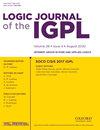Black widow optimization for reducing the target uncertainties in localization wireless sensor networks
IF 0.8
4区 数学
Q2 LOGIC
引用次数: 0
Abstract
Localization Wireless Sensor Networks (WSN) represent a research topic with increasing interest due to their numerous applications. However, the viability of these systems is compromised by the attained localization uncertainties once implemented, since the network performance is highly dependent on the sensors location. The Node Location Problem (NLP) aims to obtain the optimal distribution of sensors for a particular environment, a problem already categorized as NP-Hard. Furthermore, localization WSN usually perform a sensor selection for determining which nodes are to be utilized for maximizing the achieved accuracy. This problem, defined as the Sensor Selection Problem (SSP), has also been categorized as NP-Hard. While different metaheuristics have been proposed for attaining a near optimal solution in both problems, no approach has considered the two problems simultaneously, thus resulting in suboptimal solutions since the SSP is biased by the actual node distribution once deployed. In this paper, a combined approach of both problems simultaneously is proposed, thus considering the SSP within the NLP. Furthermore, a novel metaheuristic combining the Black Widow Optimization (BWO) algorithm and the Variable Neighbourhood Descent Chains (VND-Chains) local search, denominated as BWO-VND-Chains, is particularly devised for the first time in the author’s best knowledge for the NLP, resulting in a more efficient and robust optimization technique. Finally, a comparison of different metaheuristic algorithms is proposed over an actual urban scenario, considering different sensor selection criteria in order to attain the best methodology and selection technique. Results show that the newly devised algorithm with the SSP criteria optimization achieves mean localization uncertainties up to 19.66 % lower than traditional methodologies.减少定位无线传感器网络中目标不确定性的黑寡妇优化技术
定位 无线传感器网络(WSN)是一个研究课题,因其应用广泛而日益受到关注。然而,由于网络性能在很大程度上取决于传感器的位置,这些系统一旦实施,其可行性就会受到定位不确定性的影响。节点定位问题(NLP)旨在为特定环境获得最佳的传感器分布,这个问题已经被归类为 NP-Hard。此外,定位 WSN 通常会进行传感器选择,以确定使用哪些节点来最大限度地提高精度。这个问题被定义为传感器选择问题(SSP),也被归类为 NP-Hard。虽然人们提出了不同的元启发式方法来获得这两个问题的近似最优解,但没有一种方法能同时考虑这两个问题,从而导致次优解的出现,因为 SSP 在部署后会受到实际节点分布的影响。本文提出了同时解决这两个问题的综合方法,从而在 NLP 中考虑了 SSP。此外,作者还首次针对 NLP 设计了一种结合了黑寡妇优化(BWO)算法和可变邻域后裔链(VND-Chains)局部搜索的新型元启发式,称为 BWO-VND-Chains,从而产生了一种更高效、更稳健的优化技术。最后,考虑到不同的传感器选择标准,在实际城市场景中对不同的元启发式算法进行了比较,以获得最佳方法和选择技术。结果表明,新设计的算法采用 SSP 标准优化,与传统方法相比,平均定位不确定性降低了 19.66%。
本文章由计算机程序翻译,如有差异,请以英文原文为准。
求助全文
约1分钟内获得全文
求助全文
来源期刊
CiteScore
2.60
自引率
10.00%
发文量
76
审稿时长
6-12 weeks
期刊介绍:
Logic Journal of the IGPL publishes papers in all areas of pure and applied logic, including pure logical systems, proof theory, model theory, recursion theory, type theory, nonclassical logics, nonmonotonic logic, numerical and uncertainty reasoning, logic and AI, foundations of logic programming, logic and computation, logic and language, and logic engineering.
Logic Journal of the IGPL is published under licence from Professor Dov Gabbay as owner of the journal.

 求助内容:
求助内容: 应助结果提醒方式:
应助结果提醒方式:


